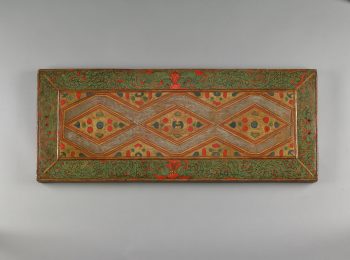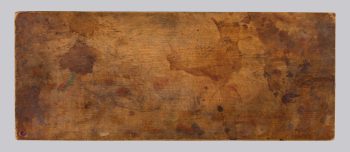Tibet
13th century


Tibet
13th century


Wood book covers often received elaborate treatment in Tibet, reflecting the importance of the texts that they protected. Hardwood is relatively rare in many areas of Tibet, and the thick pieces of wood used for each book cover represented great effort and expense.A traditional Tibetan book has two covers that are used to enclose stacked unbound paper pages. The book is then wrapped in fabric to protect the pages from separation, dust, and smoke. The carved and painted decoration of this book cover is typical of work done in the thirteenth century. Such covers frequently display geometric patterns and have some shallow carving. They are usually varnished and thus appear glossy although they are created with the same mineral pigments as Tibetan scroll paintings.
Teachings and precepts that offer practical and experiential guidance. In Buddhism instruction is primarily an oral tradition and is often targeted to the specific needs or disposition of a student or disciple.
The antidote to ignorance, with the highest form of wisdom being an understanding of the true nature of reality and all phenomena. In Buddhism studying the nature of interdependence and emptiness is considered an important step for attaining wisdom.
Today, Tibetans primarily inhabit the Tibetan Plateau, situated between the Himalayan mountain range and the Indian subcontinent to the west, Chinese cultural regions to the east, and Mongolian cultural regions to the northeast. During the 7th to 9th century, Tibetan rulers expanded their empire across Central Asia, and established Buddhism as the state religion.
Get the latest news and stories from the Rubin, plus occasional information on how to support our work.